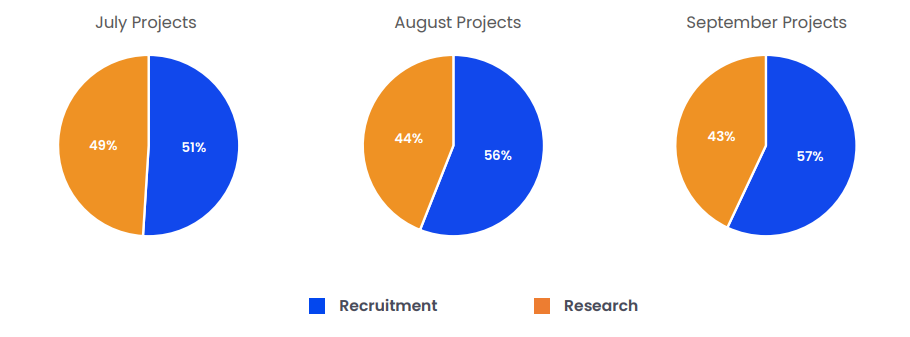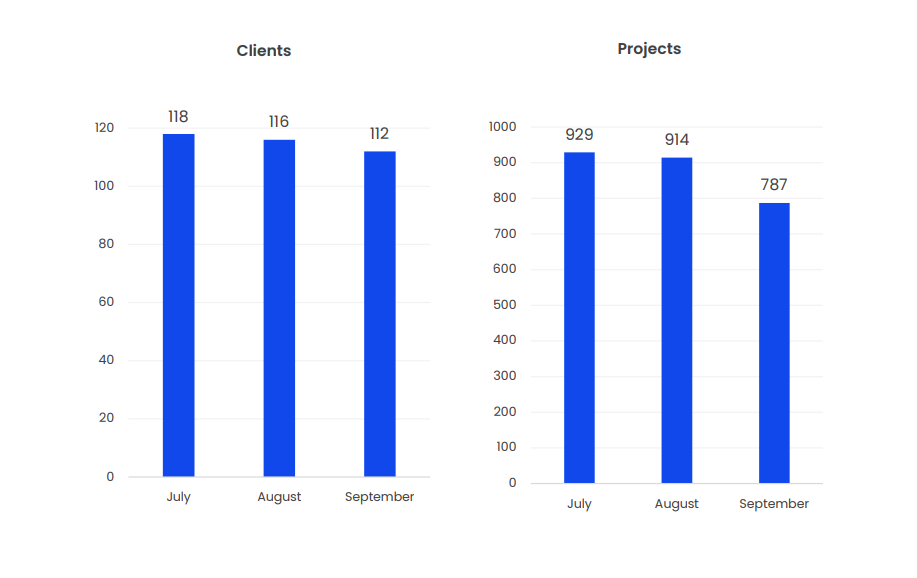A quarterly digest of facts, figures and opinion from the Talent Acquistion Sector

What do you really want to know?
If you ask the same questions as everyone else, you’ll get the same answers
At WhiteCrow Research we provide bespoke insight.
Instead of dealing in generic, off-the-shelf industry reports, we serve up originally sourced proprietary data which answers a client’s specific needs. In other words, whatever you want to know, we’ll find it out for you. Within reason, of course.
But the fact is, roughly 80% of our work has traditionally fallen into the same few categories. Talent Mapping, Diversity Studies, Location Analysis, Salary Benchmarking . . . It’s only the occasional client who asks for something a little off-piste.
But that seems to be changing.
Over the last year we’ve seen a notable increase in what might be described as ‘left-field’ research requests. These include the energy giant who wanted to break down the maintenance costs of over 100 oil & gas plants; the insurer who asked us to find out the C-level titling policy at 10 key competitors; and the global healthcare business who wanted a deep-dive analysis on the diagnostics set-up (cost, revenue, headcount, future strategy) across five of its rivals.
These and other clients have realized that talent intelligence is being utilized by an increasing number of companies.
And we’re not just talking about hiring managers. Nowadays, insight is being commissioned by leaders in HR, Strategy, Legal, Transformation and plenty of other functions.
That creates both challenge and opportunity. On the one hand, it means if you’re only asking ‘vanilla’ questions around talent demographics then you’re not really gaining a competitive edge. There’s a fair chance all your rivals have the same information. But on the other hand, this forces you to ask yourself the million-dollar question: what piece of insight would really make a difference to your business?
The answer will be different for everyone but if you get the answer you need, then you’ll stay one step ahead of the competition.
One thing’s for certain. The days where TA teams just spent their time putting together lists of potential candidates are well and truly over. The future is all about insight. What do you want to know?
The World According to WhiteCrow

As the world’s largest sourcing and recruitment company, WhiteCrow works with clients across multiple geographies and sectors. So, a brief glance at what we’re working on ought to provide a clue to what’s going on in the wider market
Over the last quarter, the data tells us this:
- Among our top 10 clients by number of projects were a global energy giant, two tech companies, two consumer goods brands, a consulting firm and a global logistics business. This speaks to a recruitment sector in excellent health, with hiring underway across multiple sectors.
- True, there was a dip in September, but we do not view this as an indication of a more prolonged downturn. Firstly, several projects completed successfully in August and, secondly, it is the case that the summer lull (as it used to be known) is now more unpredictable. Whereas previously hiring managers would reliably go on holiday over July/August, now the holiday season stretches over many months. You know there will be a slight blip in hiring activity somewhere between April and October, but you just don’t know when.
- We spoke at the top of this newsletter of the increasing number of recruiters who now take a strategic approach to their role, acting as genuine partners to the business and providing not just candidates, but data and insight, often via the auspices of WhiteCrow. This is perhaps reflected in the fact that during July almost 50% of our projects were research focused. What’s more, plenty of our recruitment projects these days come with added data analysis and market demographics.
- In summary, these are exciting times to be a partner to the global TA community. With recruiters working harder than ever to bring value to their business colleagues, we’re seeing an unprecedented variety of engagements across every conceivable sector. If your company would like a free seminar on how other businesses are using talent intelligence to transform TA delivery, just let us know. We’d be happy to oblige.


Talentomics
Whatever your view on the big issues of the day, we can all agree these are unpredictable times. That’s a nightmare for workforce planning. So now more than ever Talent teams need to be across the numbers. Below, we share a selection of economic charts and comment briefly on their implications for recruitment.
1. Back to the office, back to the future…

- The above names all feature on Business Insider’s rolling list of companies which are demanding remote workers return to the office.
- What’s interesting is how many of them are tech brands. Ironic, you might say. With their generous perks, relaxed dress codes and trendily appointed break-out spaces, the likes of Google and Meta were among the first companies to challenge traditional ways of working. Eventually, this culminated in the easygoing work culture that they’re now trying to change back to something more conventional.
- If they can, that is . . . The problem a lot of companies will have is that much of their post-pandemic recruitment involved hiring employees based many hours distant from any local office. It’s one thing for Google to ask someone in the Bay Area to drive a few miles down the road to Menlo Park, but how does a company in, say, New York, persuade a software engineer in Bangalore to start showing up in the office?
- There’s a warning here for companies who may be somewhere in between these two scenarios; if you think you might start asking workers back to the office any time soon, then you need to put the brakes on your globalized recruitment strategy soon
2. Born again recruitment

As we discuss in our editorial, the best TA leaders think strategically. That means they gather insight, not just about today’s talent marketplace, but also tomorrows.
- As we discuss in our editorial, the best TA leaders think strategically. That means they gather insight, not just about today’s talent marketplace, but also tomorrows.
- In that light, it’s worth considering a selection of fertility rates by country. Bear in mind, the fertility rate required to replace a country’s population is 2.3, so if the above figures stay roughly the same over the coming years, then a lot of European countries are facing a huge worker shortage.
- By contrast, the population across most African countries is set to soar. If these countries can continue to industrialize and upskill at the same time, then they become obvious outsourcing destinations for the future.
- Some of our clients are already thinking in these terms. We’ve completed a number of location analysis studies recently, although they’ve mostly been focused on countries such as India, Mexico and the Philippines. Might be time to start considering some of the safer African states instead. For example, with a Global Safety Index rating of 1.7 and a fertility rate 3.4, why not take a closer look at Ghana?
3. Declining candidate experience

- According to recent research by CANDE, candidate satisfaction in the recruiting process is fast declining. In 2019, North American NPS score ratings for ‘interview fairness’ were 74 whereas today they are down to 58. A host of other statistics tell a similar story.
- But shouldn’t the scores be going in the other direction? We all know that candidates these days are more empowered than they used to be, having made their voices heard on several issues including diversity, corporate purpose and employee welfare.
- This rebalancing of worker/employer relationships has been underway for a number of years, but it was turbo-charged by lockdown, following which plenty of candidates demonstrated their newfound power Statistics from 2023 Global Candidate Experience Benchmark Research Report by refusing even to come into the office.
- So, at a time when companies should be trying desperately to improve candidate experience, why is it going backwards? Our guess is that technology has a lot to do with it. A recent recruitment conference we attended trumpeted the opportunities of AI, but the emphasis was all on the employer. Faster selection, robot interviews, automated rejections . . . That’s all very well, but isn’t it about time companies considered the effect that tech has on the very people they are trying to attract?
- It’s perhaps worth noting that CANDE’s report shows NPS ratings for remote interviews are far worse than for those conducted in person.

This was the incredulous response when one of our researchers contacted a candidate to tell them they didn’t get the job. The implication, it seems, is that most recruiters these days simply don’t bother to update unsuccessful applicants
At WhiteCrow we take a strong view on this. It should be a matter of courtesy to close things off with all candidates, successful or otherwise, but it’s also good business. We may wish to contact that person again in the future and we don’t want to set ourselves up for a frosty reception: Oh yes, I remember you. You were the guy who made me go a long to all those interviews and then ghosted me . . . More importantly, we have a duty to our client to protect their brand. The last thing we need is a bunch of disgruntled candidates telling the market what a terrible experience they had with such-and-such a company.
The hiring process is becoming ever more digitalized and that’s a fine thing. It creates huge efficiencies for recruiters, candidates and companies. But in the rush to embrace technology, there’s a danger that we overlook three vital components of any truly effective recruitment strategy.
Candidate management. Corporate branding. And good old-fashioned courtesy.

Wordplay
Like any industry, recruitment has its lexicon of odd words and phrases. The best of these serve to illuminate complex topics; the worst merely confuse and obfuscate. As for the rest, well, let’s take a closer look . . .


Chocolate. Cryptocurrency. Diagnostics. Supply chain. Interior design. Dogs. Diversity. Marketing. Energy transformation . . . These are just a few of the many thousands of things that LinkedIn users claim to be ‘passionate’ about. Could there be a touch of word inflation going on here?
The Oxford dictionary defines ‘passionate’ as “having very strong feelings or emotions”. So probably an appropriate word when applied to one’s partner or a pressing social issue such as eradicating malaria. But chocolate?
The problem is that word inflation, like currency inflation, is only ever temporary.
Eventually, they both come crashing back down again. If everyone is ‘passionate’ about everything then the word loses all meaning. Instead of conveying obsessive, all-consuming fascination, it merely suggests a certain lazy disengagement from the very subject you’re claiming to feel so deeply about.
So what word should LinkedIn users deploy instead? Our advice would be ‘show don’t tell’. By sharing your experience, habits and achievements, it soon becomes obvious what’s important to you. What’s that you say? You eat three Snickers bars, two Toblerones and an Easter egg for breakfast every morning? Gosh. Sounds to me like you might be passionate about something.
Contact
To discuss any of the issues raised in this month’s newsletter or to explore how WhiteCrow Research can help with any of your talent insight and recruitment needs, please contact us.


